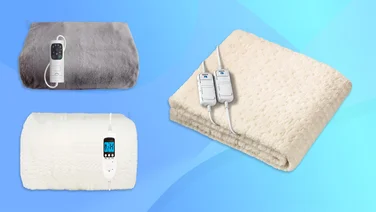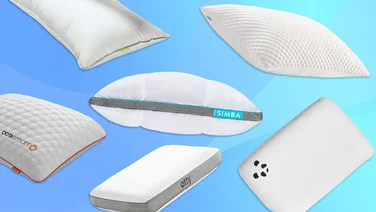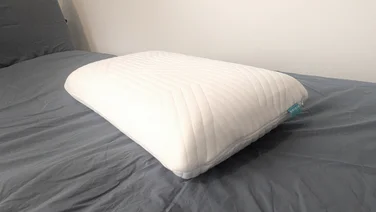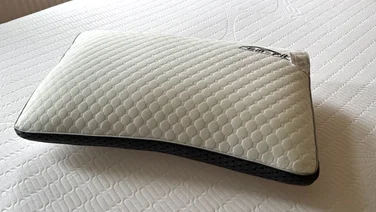To help us provide you with free impartial advice, we may earn a commission if you buy through links on our site. Learn more
- Can all pillows be washed?
- How often should you wash pillows?
- How to wash pillows in the washing machine
- What detergent should I use to wash my pillows?
- How to hand wash pillows
- How to clean pillows without water
- How to remove yellow stains from pillows
- How should you dry pillows after washing?
- How to wash pillows step-by-step

While you might be confident about how to keep your bed sheets crisp and clean, many of us are less clued up about how to wash pillows. Over time, our bedding – including pillows – can harbour dust mites and experience yellow staining as the fabric absorbs natural body oils, sweat and skin cells.
Spot cleaning is great for occasional spills and the odd stain, but when your pillows are starting to look and smell a bit stale, it’s time for a more thorough clean. If you’re not sure about how to wash pillows without ruining them, you’re not alone.
Thankfully, this task is pretty straightforward, as long as you observe a few hard and fast rules. Follow our top tips and guidance from sleep experts and you’ll soon get your pillows back to their clean and comfy best without a lump or bump in sight.
READ NEXT: Best washing machines
Can all pillows be washed?
It’s important to check what your pillow is filled with, as not all materials are suitable for traditional washing. TEMPUR sleep specialist, Thomas Høegh Reisenhus, says: “As a general rule of thumb most down, feather, polyester and fibrefill pillows can be cleaned in a washing machine, while memory foam, TEMPUR and latex pillows can’t.”
How often should you wash pillows?
Water-safe pillows require a wash roughly every three to six months to keep them clean and cared for but even with careful cleaning, all pillows will deteriorate. TEMPUR’s Reisenhus advises replacing pillows fairly regularly: “Despite regular cleaning, bacteria will build up, so it’s important to replace your pillow every three years. Not only will this mean you get to enjoy a clean and fresh pillow but you’ll likely find it much more comfortable as well.”

Looking for a new pillow? See our guide to the best microfibre, memory foam and down pillows.
READ NEXT: Best integrated washing machines
How to wash pillows in the washing machine
Even if your pillow is safe for machine washing, there are still a few things to consider to protect both the pillows and your washing machine. First, ensure that your pillow does not have any holes or loose stitching that could cause the filling to escape in the wash and damage the machine. You should also pay attention to the capacity of your washing machine, as overloading will prevent the pillows from being cleaned effectively.If possible, Sophie Lane, Product Training Manager at Miele advises washing two at a time. She says, “It’s best to wash two pillows together, while adhering to the maximum load size of your washing machine, to ensure that the machine remains balanced.”
You should also check the care instructions of your pillows when choosing a cycle. Lane says, “Observe the maximum temperature and agitation – a gentle programme is most suitable. If washing down-filled pillows, then use a dedicated programme if available.”
What detergent should I use to wash my pillows?
Any everyday, mild detergent will be fine for washing most pillows, though you can pick up one specially formulated for synthetic or natural down. Any stains can be pretreated before washing by spot-cleaning with detergent or specialist stain remover.
READ NEXT: Best eco-friendly detergents
How to hand wash pillows
If your pillows won’t fit in your washing machine, then you can wash by hand just as effectively. Hand wash pillows by submerging in the bath using a capful of detergent and warm water, then massage the pillow evenly to remove dirt. Next, be sure to gently squeeze out any excess water once you’ve finished to speed up the drying time.
How to clean pillows without water
If your pillows aren’t water-safe or you’re worried about being able to dry them in time for bed, you can consult a professional dry cleaner for specific advice. If you opt for a dry clean, it’s best to leave the cleaned pillows to air in a well-ventilated area before sleeping on them.

Alternatively, you can clean pillows naturally on a sunny day. Rachel Marshall, Brand Manager at Bensons for Beds says, “Pillows that can’t be washed with water can be regularly aired in direct sunlight, as UV rays can help kill bacteria and freshen the fabric. Sprinkle baking soda liberally over the pillow surface and let it sit for several hours to absorb odours, then vacuum thoroughly to remove the baking soda residue. Consider adding a few drops of essential oils to a cloth and gently dabbing it over the pillow to impart a fresh scent. Use a handheld vacuum cleaner with an upholstery attachment to remove dust, hair and debris from the surface of the pillow.”
READ NEXT: Best memory foam pillows
How to remove yellow stains from pillows

Yellow staining occurs naturally over time but is unsightly and unhygienic. Thankfully, Emily Attwood of bedding brand Scooms says it’s possible to restore yellowed pillows to their former glory: “Use baking soda and vinegar as a natural cleaning option to help remove any staining. Create a paste by mixing baking soda with a small amount of water, and start by doing a spot test in an inconspicuous area to test. Once you’re happy, apply the paste directly to the stained area and allow it to sit for 15 to 30 minutes. Once the paste has sat, dampen a clean cloth with white vinegar and blot the area to help lift the stain and paste. Rinse the pillow thoroughly with water, then follow the remaining cleaning instructions on your pillow to give it a thorough wash.”
READ NEXT: Best tumble dryers
How should you dry pillows after washing?

Not all pillows are suitable for tumble drying, so check the label for advice and dry on the lowest possible setting. If possible it is always best to leave the pillow to dry naturally in the sun for the best results or in a warm place, such as the airing cupboard. It is vitally important to dry pillows thoroughly to avoid mould and mildew forming.
How to wash pillows step-by-step
1. Ensure your pillow is suitable for machine washing and that the pillow is not suffering from loose seams or stuffing loss
2. Pre-treat any stains directly with detergent or a natural baking soda and vinegar solution
3. Load two at a time into the washing machine to wash at a cool temperature on a delicate cycle with limited spin
4. If handwashing, pre-treat stains as before, then submerge in the bath with a capful of gentle detergent and carefully massage clean
5. Reshape your pillows once the washing is finished and leave plenty of time for drying. Dry flat in the sun if possible, otherwise leave in a warm, well-ventilated room or airing cupboard for a few days until completely dry
6. If tumble drying, select a low heat setting and use tumble dryer balls if possible to maintain the best shape






